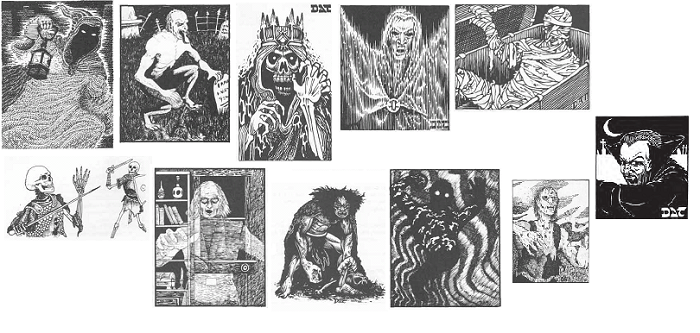I was reading up on the various undead in the Monster Manual, and noted which ones in their descriptions specifically mentioned throwing holy water on them would hurt them. [Part 2] [Part 3]
For some reason, the articles on ghouls, ghasts, shadows, ghosts, and liches do not mention them being affected by holy water. I thought this was wrong, so I turned to the DMG and found on p. 65 “All forms of undead, as well as creatures from the lower planes (demons, devils, night hags, night mares, nycadaemons, etc.) are affected by HOLY WATER.”
Similarly, “Paladins, lammasu, shedu, ki-rin, and similar creatures of good alignment (or from the upper planes) are affected by UNHOLY WATER.”
In addition to affecting undead, on p. 228 in the glossary of the DMG, it says, “Useful as a weapon against undead or to slow the effects of poison.” Further on p. 115 it slows the effects of becoming a lycanthrope or undead for 1-4 turns.
I also found the bit on holy/unholy areas having an affect on the ability to turn on p. 66 of the DMG.
And of course the ability to make holy/unholy water is limited to at least a 5th level cleric with a font. Fonts are limited to one per religious edifice. and can only be used once per week. See pages 114-115 DMG. If there is a sudden outbreak of undead, the availability and cost of holy water will be a factor. Determining the day of the week the cleric makes holy water will determine just how many spells for healing or other purposes the cleric has prepared that day. Of course, this will only be an issue if there is only one cleric of sufficient level to create holy water.
Some undead have the ability to create like or lesser versions of themselves, from those they have slain. Skeletons and Zombies lack this ability, but Ghouls have it. The AD&D ghoul is the closest analog to zombies in relatively recent media that cause those killed by them to become one of them.
Ghasts are a “super ghoul”, in that their paralyzing touch can affect elves, but it doesn’t mention that those killed by a ghast become a ghast. I would rule that they do, since they are otherwise identical to ghouls.
Of the higher order undead, mummies, ghosts, and liches victims do not become undead. Of these, only a ghost’s victims are permanently dead. The ghost is the only undead with such an unforgiving and irreversible condition. I would rule that a limited wish, wish, or alter reality spell could change that.
Draining powers have some variability. Shadows drain strength, while wights, wraiths, spectres, and vampires drain levels. Ghosts are the only one that age.
Oddly, only the ghoul and the ghast are mentioned as being repulsed by circles of protection. I would rule that the right efforts put into such protections would be effective. This only makes sense, since holy symbols in the hands of clerics are beneficial.
The different speeds of undead is also interesting. The slowest are zombies, mummies, and liches at 6″. The fastest land speeds are ghasts and shadows at 15″. With flying speeds of 18″ for vampires in bat form, to 24″ for wraiths, and 30″ for spectres.
It appears that only ghouls and ghasts get 3 attacks per round. All the rest only get 1 attack per round.
The fear affect by some undead is quite powerful, either causing one to flee, or be inactive with fear, in the cast of a mummy, or flee in fear if under 5th level for a lich. The fear effect of a lich is even greater than that of a huge ancient dragon which “only”
affects up to 4th level characters/4 HD monsters. Since a lich is at least an 18th level magic user, it makes sense that their fear effect is greater, as an 18th level magic user, who acted smartly, should be able to take out an ancient dragon on their own. Thus, the power of a lich could easily result in a cooperative agreement between the lich and an ancient dragon.
The groaning spirit (banshee) is an undead, but is not listed on the turning table. It falls between the mummy and the spectre in hit dice, so consider its special abilities and defenses when deciding where to place it on the turning table.
I find it interesting that a wight has more hit dice than a ghast, but the ghast is harder to turn. With that exception, the turning table on p. 75 of the DMG is in HD order.
As I prepared the image to go with this article, I realized that Dave Trampier seems to have illustrated all of the undead.
Of course, this is only the undead in the original Monster Manual. A separate article or more may be needed to review the undead in the Fiend Folio, Monster Manual II, and other AD&D resources.
Read Part 2 here.
NOTE: All the links for the AD&D books are Affiliate Links that help me support my RPG/Blogging habit.

